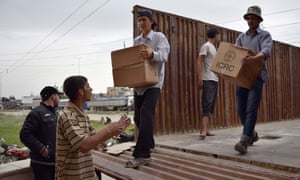
On 21 April, I took my sixth trip to a besieged area in Syria – a place called Rastan, half an hour’s drive north from Homs. I was part of a joint team dispatched by the International Committee of the Red Cross (ICRC) and Syrian Arab Red Crescent to bring humanitarian aid to more than 120,000 people for the first time in over a year.
We crossed the frontline during the day – in contrast with previous visits to besieged areas, when we have generally only been allowed in after dark – and stayed deep into the night. All such trips have unique challenges, but they are nothing compared to the daily hardships faced by people in besieged areas.
Sadly, places like Rastan, where civilians are trapped between the warring sides, have become a common reality of the Syria conflict. People pay a huge price, struggling to survive in dangerous areas where food, water, healthcare and safety are all scarce.
Rastan is a beautiful, green area, its hills covered by agricultural land famous for its olives trees and vegetables. The town’s trademark black stones stretch as far as the eye can see, all the way to the mountains on the horizon. Before the war, people here lived their own settled lives.
Not any more. Rastan’s farmlands have become frontlines. Olives, once a source of income, have instead become a dietary staple. For locals who decide to continue farming, life has become a perilous battle to survive under siege. One local doctor described the siege as a life without a life: you wake up, go about your daily activities, but don’t really live. You don’t develop; there is no access to books, no seminars or symposiums with colleagues. You work to save lives, if you have a chance. Very often you don’t. Then you just wait – for a year, two years, five – hoping the ordeal will end.
In early February, we waited for hours at the gates of Moadamiyah, another besieged locality close to Damascus. Thousands of people had gathered on the edge of the buffer zone outside the town, waiting for us to bring in food and medicines.
Once inside, I met Salam, a 14-year-old girl suffering from liver problems for which treatment and medicines are all but impossible to find in a besieged area. Her voice cracking, she tearfully described her feelings, her sense of life’s futility. She questioned why she was going to school when she saw no future. Such hopelessness is a common thread among people I meet in areas under siege.
No comments:
Post a Comment